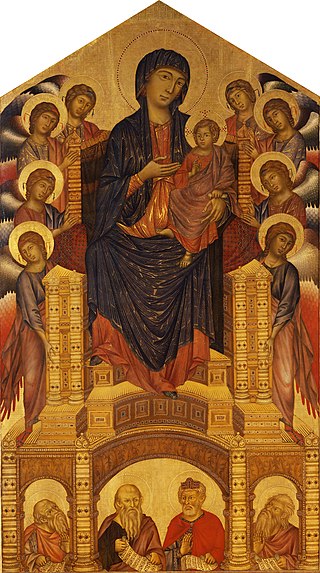
Cimabue, c. 1240 – 1302, was an Italian painter and designer of mosaics from Florence. He was also known as Cenni di Pepo or Cenni di Pepi.
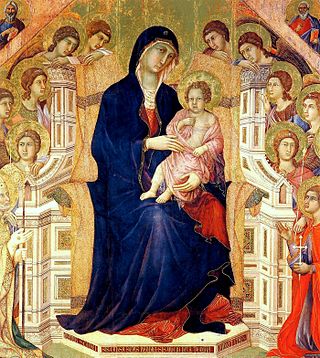
Duccio di Buoninsegna, commonly known as just Duccio, was an Italian painter active in Siena, Tuscany, in the late 13th and early 14th century. He was hired throughout his life to complete many important works in government and religious buildings around Italy. Duccio is considered one of the greatest Italian painters of the Middle Ages, and is credited with creating the painting styles of Trecento and the Sienese school. He also contributed significantly to the Sienese Gothic style.

Benozzo Gozzoli was an Italian Renaissance painter from Florence. A pupil of Fra Angelico, Gozzoli is best known for a series of murals in the Magi Chapel of the Palazzo Medici-Riccardi, depicting festive, vibrant processions with fine attention to detail and a pronounced International Gothic influence. The chapel's fresco cycle reveals a new Renaissance interest in nature with its realistic depiction of landscapes and vivid human portraits. Gozzoli is considered one of the most prolific fresco painters of his generation. While he was mainly active in Tuscany, he also worked in Umbria and Rome.
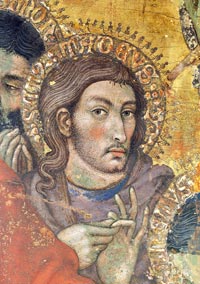
Taddeo di Bartolo, also known as Taddeo Bartoli, was an Italian painter of the Sienese School during the early Renaissance. His biography appears in the Vite of Giorgio Vasari, who claims that Taddeo was the uncle of Domenico di Bartolo.

Montopoli in Val d'Arno is a comune (municipality) in the Province of Pisa in the Italian region Tuscany, located about 40 kilometres (25 mi) southwest of Florence and about 30 kilometres (19 mi) east of Pisa.
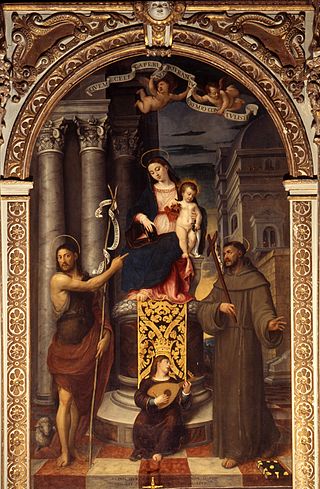
Francesco Beccaruzzi was an Italian painter of the Renaissance era, active near his hometown of Conegliano and in the neighborhood of Treviso. He was influenced by both Il Pordenone and later Titian. He painted Saint Francis receiving stigmata (1545) from Conegliano, but now in the Gallerie dell'Accademia in Venice.

Lippo Memmi was an Italian painter from Siena. He was the foremost follower of Simone Martini, who was his brother-in-law.
Giovanni Battista Bertusio was a painter of the early-Baroque period, active in Bologna. He trained initially under Denys Calvaert, then under Ludovico and Agostino Carracci. He married the painter Antonia Pinelli.

Bastiano di Bartolo Mainardi (1466–1513) was an Italian painter of the Early Renaissance. He was born in San Gimignano and was active there and in Florence.

Benedetto Buglioni (1459/1460–1521) was an important Italian Renaissance sculptor specialised in glazed terracotta.
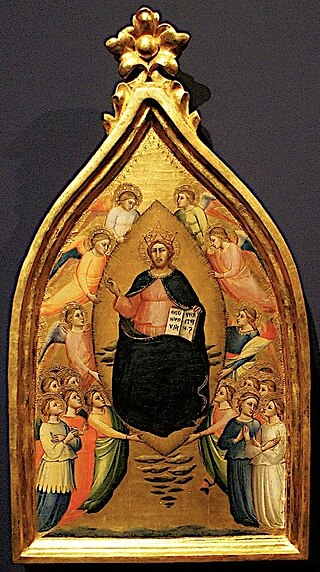
Mariotto di Nardo di Cione was a Florentine painter in the Florentine Gothic style. He worked at the Duomo of Florence, the church of Santa Maria Maggiore, and the Orsanmichele. He created both frescoes and panel paintings, and was also active as a manuscript illuminator.
Antonio da Faenza was an Italian painter and architect active in Emilia-Romagna and Marche, active in a Renaissance style. The documentation on Antonio da Faenza is confused because, different authors have referred to him by various names including:

Marti is a village in Tuscany, central Italy, administratively a frazione of the comune of Montopoli in Val d'Arno, province of Pisa. At the time of the 2001 census its population was 1,046.
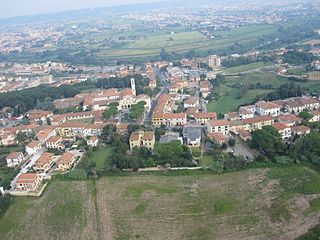
San Romano is a town in Tuscany, central Italy, administratively a frazione of the comuni of Montopoli in Val d'Arno and San Miniato, province of Pisa. At the time of the 2001 census its population was 4,417.
The Museum of Religious Art' is an art gallery and museum in Certaldo, opened in 2001 and one of the town's three museums.

Simone De Wobreck was a 16th-century Flemish painter, whose known works all come from his long period in Sicily.
The Diocesan Museum of Palermo is a museum of religious art in Palermo on Sicily, housed in a number of rooms in the Palazzo Arcivescovile opposite Palermo Cathedral.
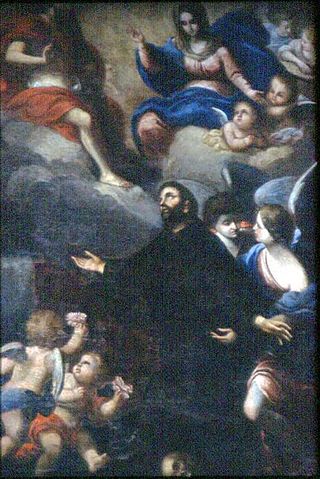
Andrea Carrera or Carreca was an Italian Baroque painter mainly active in Sicily. He was born in Trapani and died in Palermo.

The Pinacoteca e Museo Civico di Volterra is located in the Palazzo Minucci-Solaini on via de' Sarti #1 in the town of Volterra, province of Pisa, region of Tuscany, Italy.















